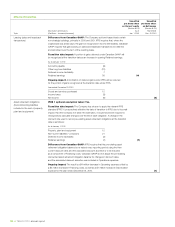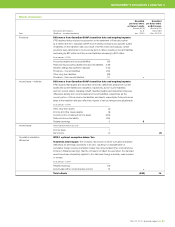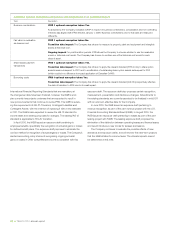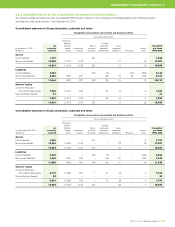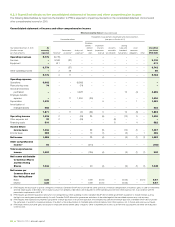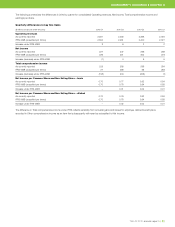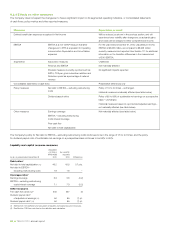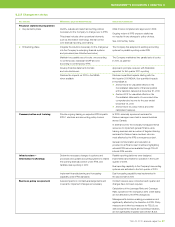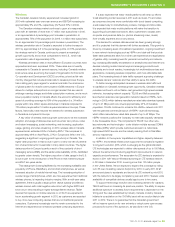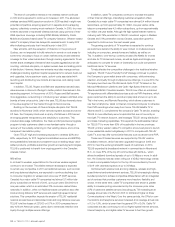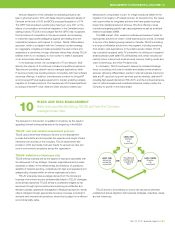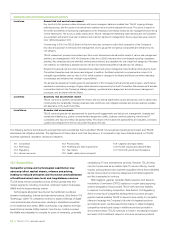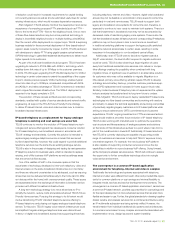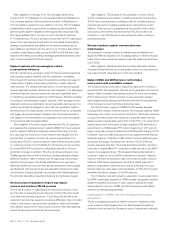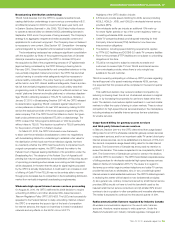Telus 2010 Annual Report Download - page 93
Download and view the complete annual report
Please find page 93 of the 2010 Telus annual report below. You can navigate through the pages in the report by either clicking on the pages listed below, or by using the keyword search tool below to find specific information within the annual report.
TELUS 2010 annual report . 89
It is also expected that major mobile platforms will ramp up efforts
to sell streaming content services in 2011 such as music, TV and video
as consumers become more comfortable with cloud-based computing,
a web-based way to cost-effectively process, manage and store data.
It is expected that major mobile platforms will make the transition to
supporting cloud-based services to allow customers to access both
corporate and personal data (i.e. photos, streaming video, music)
from virtually anywhere and on any device.
The demand for wireless data services has been growing strongly
and it is projected that this demand will further accelerate. This growth is
driven by increasing levels of broadband penetration, ongoing investment
in new network technologies such as HSPA+ and dual-cell that provide
faster data speeds and allow for a richer user experience and applications
of greater utility, increasing need for personal connectivity and network-
ing, increasing affordability and selection of smartphones and Internet-only
devices including mobile Internet keys and emerging products such
as tablets and e-book readers, increasingly rich multimedia services and
applications, increasing wireless competition, and more affordable data
plans. The increasing levels of data traffic represent a growing challenge
to wireless carriers’ networks and their ability to serve this traffic.
To better manage anticipated increases in wireless data traffic and
to capitalize on Canada’s wireless growth opportunity, Canadian wireless
providers continue to roll out faster, next generation high-speed wireless
networks, increasing network capacity. TELUS and Bell successfully
launched an extensive next generation network based on HSPA+ tech-
nology in 2009, which delivers manufacturer-rated data download speeds
of up to 21 Mbps and now covers approximately 97% of Canada’s
population. TELUS continued to enhance this HSPA+ network into 2011
with the planned commercial launch of HSPA+ dual-cell technology,
which offers manufacturer-rated data speeds of up to 42 Mbps. The
HSPA+ network positions the Company to meet data capacity demands
in the foreseeable future. This complements TELUS’ two other wire-
less networks and technologies – code division multiple access (CDMA)
and Mike (iDEN), which provide customers access to a nationwide
high-speed EVDO service and the industry-leading Push to Talk Mike
service, respectively.
In addition to the superior capabilities and higher capacity delivered
by HSPA+, this wireless infrastructure supports the company’s migration
to long-term evolution (LTE), which is emerging as the global standard.
LTE technologies are expected to deliver data speeds of up to 100 Mbps,
while at the same time introducing significant improvements in network
capacity and performance. The ecosystem for LTE devices is expected to
evolve in 2011 with Verizon Wireless launching an LTE wireless network
in 38 cities in December 2010, covering more than 110 million people
in the United States. Verizon expects to expand this coverage by rolling
out LTE over its existing network footprint by 2013. In early 2011, AT&T
announced plans to accelerate and launch its LTE network by mid-2011,
with the network to be largely complete by year-end 2013. However, wide
availability of compatible devices usually lags by one to two years.
To support technology evolution and increasing demand for capacity,
TELUS will focus on increasing its spectrum position. The ability to acquire
additional spectrum to address future requirements is dependent on the
timing and the rules established by Industry Canada. Industry Canada
initiated a consultation on the 700 MHz band with an auction likely in late
2011 or 2012. There is no guarantee that the Canadian government
will not reserve spectrum for new entrants or adopt some open access
provisions for some of this spectrum, as was done in the U.S.
MANAGEMENT’S DISCUSSION & ANALYSIS: 9
Wireless
The Canadian wireless industry experienced increased growth in
2010 with estimated year-over-year revenue and EBITDA increasing by
approximately 5% and 3%, respectively (3.2% and 3.1% in 2009).
The Canadian wireless market continues to grow at a reasonable
pace with an estimate of more than 1.7 million new subscribers in 2010,
or an approximate 4.4 percentage point increase in penetration to
approximately 73% of the population (in 2009, 1.4 million new subscribers
for an approximate 3.6 percentage point increase in penetration). The
wireless penetration rate in Canada is expected to further increase in
2011 by approximately 4.5 to five percentage points. At 73% penetration,
the wireless market in Canada continues to present a meaningful
growth opportunity and is most comparable to the U.S., which has
a penetration rate of approximately 97%.
Wireless penetration rates in many Western European countries have
approached and even surpassed 100%. These rates are not exactly
comparable to Canada for several reasons, including: Canada’s wireline
local service rates are among the lowest of Organization for Economic
Co-operation and Development (OECD) countries, priced as flat-rate
monthly charges that include all local calls to wireless phones; Europe
has a calling party pays regime for wireline local calls; the dominance
of global system for mobile communication (GSM) networks in Europe
allows for multiple subscriptions on a single handset that are used to
arbitrage roaming charges and inflate subscription numbers; and a much
lower population density in Canada affects the economic efficiency and
speed of providing coverage to 99% of the population (i.e. 34 million
people within nine million square kilometres in Canada compared to
730 million people within 10 million square kilometres in Europe). These
factors, historically, have reduced the demand for wireless substitution
in Canada as compared to Europe.
A key driver of wireless revenue growth continues to be the increased
adoption and usage of data services such as email, text, picture, video
and instant messaging, social networking, web browsing, application
usage, gaming and video-streaming. In 2010, wireless data in Canada
represented an estimated 25% of industry ARPU. This compares to
approximately 46% in Asia-Pacific, 27% in Europe and 34% in the U.S.,
suggesting a significant ongoing growth opportunity in Canada. The
higher data proportion in Asia is due in part to a very low rate of penetra-
tion of wired Internet to households in many Asian countries. The higher
data proportion in Europe is partly a result of the popularity of short
messaging service (SMS) and the earlier wide availability of 3G+ facilitated
by greater urban density. The higher proportion of data usage in the U.S.
is due in part to the introduction of the iPhone in that market by Apple
and AT&T two years earlier.
This data growth is being facilitated by the increasing availability and
popularity of iPhone, BlackBerry and Android smartphones, as well as
increased adoption of mobile Internet keys. The increasing adoption of
a wider range of smartphones, which are more expensive than traditional
wireless phones, is impacting industry margins. With a multi-year sales
agreement, there is usually a large upfront device subsidy provided by
wireless carriers with initial negative returns but with higher ARPU and
lower churn rates resulting in higher average lifetime revenue. Tablet
devices that operate on mobile networks or on Wi-Fi are expected to
be an accelerating growth segment in 2011, as customers are expected
to buy more new computing devices that are not traditional personal
computers. Customers increasingly want to remain connected to the
Internet and experience an enhanced portable computing experience.



